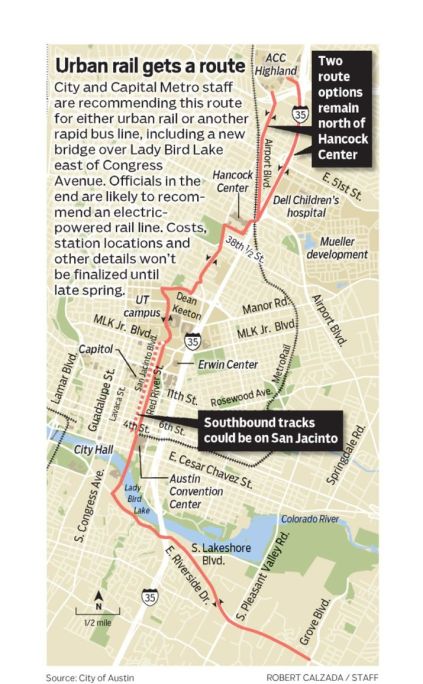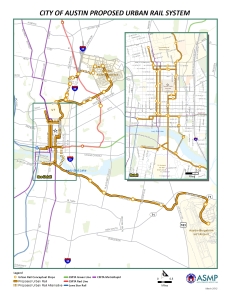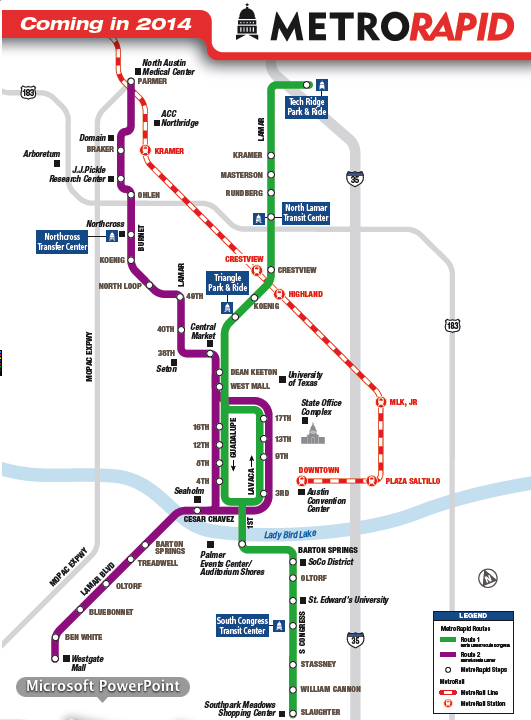Austin Headlines: Urban Rail Plan Taking Shape (again)
February 28, 2014 Leave a comment
Austin’s urban rail unveiled: Highland Mall to East Riverside Drive – Austin American-Statesman
Ben Wear – Officials proposed a nine-mile route that would run from the emerging Austin Community College campus at Highland Mall through the University of Texas, downtown and along East Riverside Drive to Grove Boulevard. The proposal is expected to take final form this summer, where the Austin City Council will decide by August whether to put a bond proposal on the November ballot.
At the moment, there are a host of unknowns: the cost of construction; annual operating costs and what entity or entities would cover those costs; who will run the line; where the train would have its own dedicated corridor; and where stations would be located. A huge question mark is how and when the line will cross Lady Bird Lake. The final recommendation that will be put to the City Council, along with details about stations, train technology, financing and governance of the line, is expected emerge by April.
South Austin’s beleaguered Violet Crown Trail moves ahead despite setbacks – Community Impact
The proposed Violet Crown Trail is a 30-mile network of trails from Zilker Park to south of FM 967 in Hays County. So far, the trail’s first phase — 5 miles of walkways in Zilker Park — has been built. Attention is now focusing on the second phase of the trail, a 7-mile segment that will link Sunset Valley to the Veloway, a popular closed cycling and skating loop, and the Lady Bird Johnson Wildflower Center. Construction is expected to get underway by early summer. For more information, see here.
Austin City Council Votes to Lower Occupancy Limits – KUT News
Council took the issue of so-called “stealth dorms” to task, passing a resolution to lower the number of unrelated adults allowed to live in a single-family home from six to four. Some argue these living arrangements provide affordability for Austinites because of the rising price of Austin real estate, while others say they lead to parking and trash problems that disrupt neighborhoods and lower property values.
‘Streets’
- Bicycle Bridge Project Begins on Mopac in South Austin – TxDOT
- Permanent food trailer court to open at 1-acre Barton Springs Road site – The Daily Texan
Bicycling
- Twice as many people as anticipated have used Austin B-cycle in it’s first two months – Austin Post
Transit
- Is Capital Metro’s new MetroRapid service leaving bus riders behind? KUT News
- Capital Metro plans to remove nearly all buses from Congress Avenue – Austin Business Journal
- Rail or fail: Austin mayor touts urban rail in final State of the City address – Community Impact
Roads/Parking
- Heading for the hills? West Lake has a vintage bottleneck – Austin American-Statesman
- Transportation planners could add lanes to Highway 183 in Northwest Austin – KVUE
- TxDOT proposes closing Woodland access to I-35 to ease congestion – Austin Post
Development projects
- High-end apartment project set for evolving area of East Austin – Austin American-Statesman
- 38-story high-rise to kick off Green Water Treatment Plant area’s transformation – Austin American-Statesman
- South Austin’s Lamar Union project filling out tenant lineup – Austin American-Statesman
Green spaces/Leisure
- Soccer Watch: A pro team and a soccer-specific stadium in Austin? – Austin Chronicle
- Master Plan: Disc golf upset permanently removed from Pease Park – Austin American-Statesman
- City prepares for Phase 2 of North Walnut Creek Trail – Community Impact
Around Texas
- Judge Strikes Down New Braunfels’ River ‘Can Ban’ – KUT News
- With three new companies, Temple sees fruits of energy boom – Austin Business Journal
- At DFW, a DART Orange Line connection to downtown Dallas mere months away – Dallas News Transportation Blog
- TxDOT to Dallas: Elevated highway separating Deep Ellum from downtown will remain for the foreseeable future – Planetizen
- Turning Urban Blight into Urban Amenity: Houston’s Buffalo Bayou Promenade – Metropolis
Regional Matters
- Company hopes to open high-speed rail service between Houston and Dallas by 2021 – Fort Worth Star-Telegram
- TxDOT’s Oklahoma-to-Mexico passenger rail study advances – Dallas News Transportation Blog









